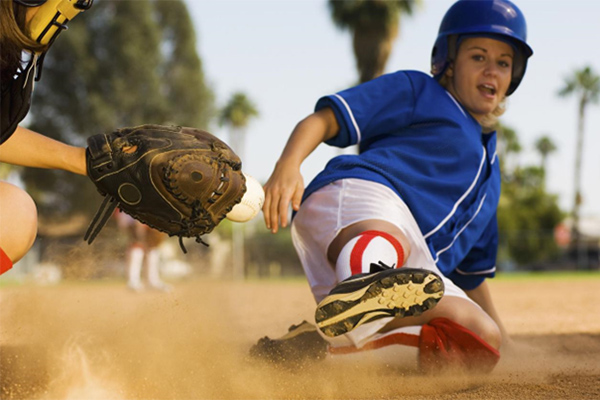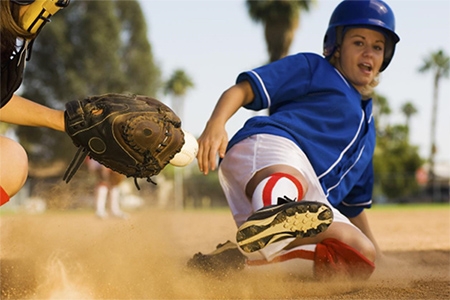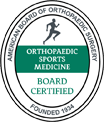
Sliding into base can be the difference between safe and out—but it’s also one of the most common ways softball players get hurt. Softball sliding injuries are surprisingly frequent and often more severe than in baseball. Understanding the risks and knowing how to prevent them is essential for staying in the game. Here’s what players, parents, and coaches need to know.
Why Sliding Injuries Happen More in Softball
Studies show that softball players are more likely to get injured while sliding compared to baseball players.1 Minor injuries like muscle pulls, ligament sprains, and abrasions are most common, but more serious issues can occur. These injuries affect various body parts including the head, face, arms, hands, knees, ankles, and feet.
Head-first slides, while sometimes faster, are also more dangerous. Research shows that head-first slides result in a higher rate of injury than feet-first slides or dives.2 The force, angle of impact, and type of base used (stationary vs. breakaway) all play a role in determining the severity of an injury.
Common Sliding Injuries in Softball
Understanding what injuries are most common can help players take the right precautions:
- Shoulder injuries: Particularly with head first sliding, a labrum tear or shoulder dislocation can occur
- Ankle Injuries: Sprains and fractures are especially common when a foot gets caught or twists awkwardly while sliding.
- Knee Injuries: Impact with the base or ground can lead to painful ligament injuries or contusions.
- Finger Fractures: Jamming fingers into the base or ground can result in breaks, especially during head-first slides.
- Skin Abrasions: These are common, especially when sliding on dry, hard infields or turf without proper gear.
- Muscle Strains and Ligament Sprains: Overstretching during a slide can lead to pulls and sprains, particularly in the hamstrings and groin.
Reduce Risk with Smarter Techniques
Proper form and technique are key to sliding safely. Players should:
- Prefer feet-first slides to reduce the risk of head, neck, and hand injuries.
- Practice tucking arms and hands during a slide to avoid impact injuries.
- Train regularly on correct sliding techniques using breakaway bases when available.
- Wear proper gear, including sliding shorts and padded clothing, to prevent abrasions.
Coaches should include slide training as part of regular practice—not just assume athletes know how to do it safely.
Strength, Conditioning, and Smart Preparation
Athletes who prepare off the field are less likely to get injured on it. Incorporating strength and mobility exercises focused on the hips, core, and legs can enhance control and minimize awkward landings. A full warm-up and cool-down routine that includes stretching also helps maintain flexibility and reduce strain.
When to Seek Medical Evaluation
Even minor injuries can become serious if left untreated. Persistent pain, swelling, or instability after sliding should be evaluated. Prompt care by an orthopedic specialist can make a major difference in recovery time and long-term performance.
Slide Smart, Stay on the Field
Sliding may be part of the game, but injuries don’t have to be. With proper technique, strength training, and awareness, players can significantly reduce their risk.
If you’ve experienced a softball injury or want expert guidance on injury prevention, schedule a consultation with Dr. DiGiulio and learn how to protect yourself while playing your best.
AUTHOR: Milan M. DiGiulio, M.D. offers comprehensive Orthopaedic care for you and your entire family, specializing in Sports Medicine and Arthroscopic surgery of the shoulder and knee. Dr. DiGiulio performs over 200 arthroscopic shoulder and knee surgeries each year, using the most advanced surgical technology. Dr. DiGiulio is an advocate of non-invasive, non-surgical treatment options such as Physical Therapy and Orthobiologics.
Reference:









